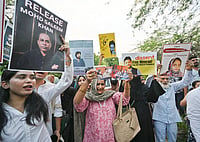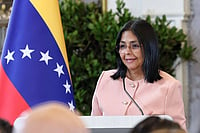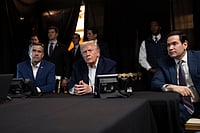It was routine because it was so predictable. On December 12, our reserves were $98.959 billion. At the accretion rate of $1.5 billion-odd a week of late and of $30 billion in the past year, this century was as deliberate as Rahul Dravid's steady knock at Adelaide. And, as happened with Dravid, our recognition got delayed because in the meanwhile we prepaid $5 billion of external debt, counted out $5.5 billion to Resurgent India Bonds investors, and gifted $498 million to the IMF.
Thus, India became the fifth forex-richest nation in Asia. You could call this the coming of age of India's liberalisation, or, after S. Venkitaramanan, RBI governor in historic 1990-91, "a challenge of affluence", or even an embarrassment of riches. But it's an embarrassment far more pleasant than the begging bowl held out to the IMF 13 years ago. A fact reflected in rating agency Standard & Poor's recent upgrading our long-term foreign currency outlook from negative to stable.
In contrast though, a lot of our forex situation does not spell long-term glory. The bulk of it flowed in short-term—about $50 billion of our reserves came in in the past two years, over half of that in 2003 alone.
That's because a 90 per cent rise in the Sensex since April made India the second best emerging market and triggered a dollar flow via foreign fund managers. Since they entered India a decade ago, FIIs made a record net investment of $7.1 billion this year.
An offshoot of this is the revaluation aspect. A steady fall in dollar vis-a-vis the strengthening of the rupee to Rs 45.5 has resulted in the reserves growing in value terms. This in turn could mean inflation inside the country. As more Indians start spending the extra cash so earned, more money will chase the same amount of goods and send prices zooming. Already inflation is up one per cent from three months ago to 5.8 per cent.
In fact, we would have reached Glory Point much earlier had the RBI allowed the rupee to appreciate freely and curbed its sterilisation efforts (converting dollar to rupees). But that would have meant political harakiri besides incurring the gravest wrath of exporters. As a result, the central bank is now faced with Hobson's choice: confidence-building through reserve accretion or allow rupee to appreciate.
A tough call, because thanks to low demand, there's excess liquidity all over the global monetary system and interest rates are down to one per cent. Wouldn't it be practical then to allow Indian companies to raise money abroad? Why then has RBI still kept the ECB window shut when despite a forex chest four times ours Chinese companies are borrowing freely?
The other convertibility measure the RBI could and should adopt is to encourage Indians to invest abroad. The government could also speed up tariff reforms. One reason why all this has not happened yet is that the bank feels the Indian economy is still demand-deficient, with low capacity utilisation, and therefore banks need to still check their exposure. The other is the volatility of external capital itself—some 30 per cent of these reserves could flow out at short notice, say, if the dollar starts rising or there's a political conflict.
The average Indian must be wondering why we do not deploy the reserves in public investment. With our government debt already at 85 per cent of gdp, even that doesn't seem a lucrative option. All the same, our precious forex reserves, so important a sign of India's virility, are costly to maintain and nurture, and earn precious little in low-yield dollar-denominated government bonds of rich countries.
Right now, with dollar outlook bleak and Indian fundamentals strong, the forex kitty is set to grow. What we need now is more do-good than feel-good.Surely there are enough economic brains in the RBI which could come up with interesting ways to utilise it to benefit the economy?
Goodbye To '91
The $1 billion milestone: time to celebrate, take stock

Goodbye To '91
Goodbye To '91
Published At:
MOST POPULAR
WATCH
MORE FROM THE AUTHOR
PHOTOS
×





















